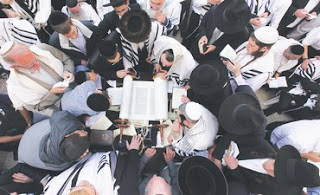Getting to the Kotel on the blisteringly sunny second day of Hol Hamoed, the intermediate days of Passover, was no easy task.
All the way from the Safra Square light rail station, visitors clogged the sidewalks of Jaffa Road – even blocking the doors of the train itself – en route to the Old City’s Jaffa Gate, a veritable testament to the art of weaving that rivaled the pedestrian chaos of New York City’s Times Square.
The exodus continued through Jaffa Gate and down the winding streets of the Old City, punctuated by a blaring musical performance at the entrance and salesmen all along the route who were eager to sell their wares to passersby in every language they could dredge up.
Jews and Christians of all colors and shapes from every corner of the world – from those in shtreimels and tzitzit to those in miniskirts and tank tops, from those in New York Knicks T-shirts to those in Victorian- era wide-brimmed chapeaus – were making their way to the city’s indisputably most popular point, the Western Wall, in Hebrew the Kotel.
All in all it took me about an hour-and-a-half to trek the mere 500 meters from Jaffa Gate to the Wall – albeit with a few wrong turns, necessary to even a veteran visitor of the area – with foot traffic coming to a complete and utter standstill at the intersection of David and Muristan streets, the cross-section between the Christian and Armenian quarters. Tour groups struggled to get by as mothers and fathers clenched their children’s wrists, and a particularly astute toddler decided to use one of the narrow stone ramps bridging the rigid cobblestone as a slide.
Turning the corner at Chain Gate and Hakotel Street, I joined an amalgamated mass – a line – next to the sign that simply reads “Wall,” indicating the final descent into the Kotel complex.
Once through security, I emerged on top of the stairwell looking down at an ocean of people, thousands upon thousands of visitors roaming the bright landscape below and clamoring to the ancient remains of the Temple’s retaining wall.
Several Magen David Adom emergency stations set up all around the area dealt with the potential consequences of the sundrenched, crowded, sweaty and densely populated venue, and also, apparently, served as a meeting point for lost children, husbands and wives as per the occasional loudspeaker announcement.
Families handed off cameras to one another, asking strangers to take their portraits in front of the sacred space as infants howled in the heat. An enormous sign at the entrance to the women’s side of the wall read “no entrance for strollers,” but strollers rolled through the gateway regardless, bumping freely among the rows of prayerful women whose children twirled around next to them.
Toward the end of my visit, as I was leaning against one of several shady wood partitions in the center of the complex, a young woman and her two little girls approached me, asking if I had a pen and paper.
Tearing a sheet out of my notebook and handing over my pen, I watched as the girls wrote what were probably their first notes to tuck into the fractures among the Kotel's stones. Shyly, one of the girls – about five years old – went to the other side of the partition to write her message. “We won’t look,” her mother told her, giggling.
When she was finished, the little girl handed me back the pen with a wide grin.
Looking around, I saw hundreds of parents and their children, religious and not, partaking in that same, generation-old tradition and celebrating freedom on that sunny day together. And I realized that no matter how we divide ourselves and how different we may be, on that Hol Hamoed Passover afternoon at the Kotel, everyone had come to the same place in search of the same thing.

No comments:
Post a Comment